It takes hours to create an impactful B2B blog post. But for busy decision-makers, those precious minutes spent reading your content can make or break their impression. The harsh reality? If your post doesn’t deliver clear value within seconds, they’ll likely move on – and your potential lead will be lost.
Statistics suggest that 44% of bloggers publish new content between three to six times monthly. As the pressure to create quality content faster rises, a strong writing system is not merely a luxury for writers but a necessity. With a strategic checklist in place, you can easily turn your blog posts into a lead-generation channel and attract prospects who don’t just qualify but also align with your company’s goals.
In this blog post, we share the ultimate blog post checklist that will boost your leads by 85%.
Pre-Writing Blog Post Checklist
At the end of the day, if you’re writing online – you want your pieces to be read. Not just read by a random person but by your ideal audience. Considering how saturated the internet is with blog posts, it’s not easy. This is why you need to strategize beforehand. Here’s a quick pre-writing blog post checklist you can follow.
1. Identify the target audience

Don’t just label who you’re targeting, dive deeper into the analytics. Understand your target audience’s objectives, aspirations, frustrations, and online behavior. What’s the style and tone that will keep them engaged? What questions are they asking? What challenges are they facing?
If your company offers web development services, there’s no point reaching out to youngsters interested in gaming gear. You must reach out to business owners who want to build a website and build their brand image.
Of course, it will take you time to gather this information. But if you use the right resources, you can make it happen with a snap of a finger. As a beginner, you can start by identifying common pain points, tracking content performance, and analyzing comments to get an idea.
With time, you can level up and shift your focus on social media listening tools like Brandwatch or Sprout Social to uncover the conversations of your target audience online. Conduct short and targeted interviews with existing customers or ideal customer profiles to identify their needs and pain points.
2. Set SMART goals
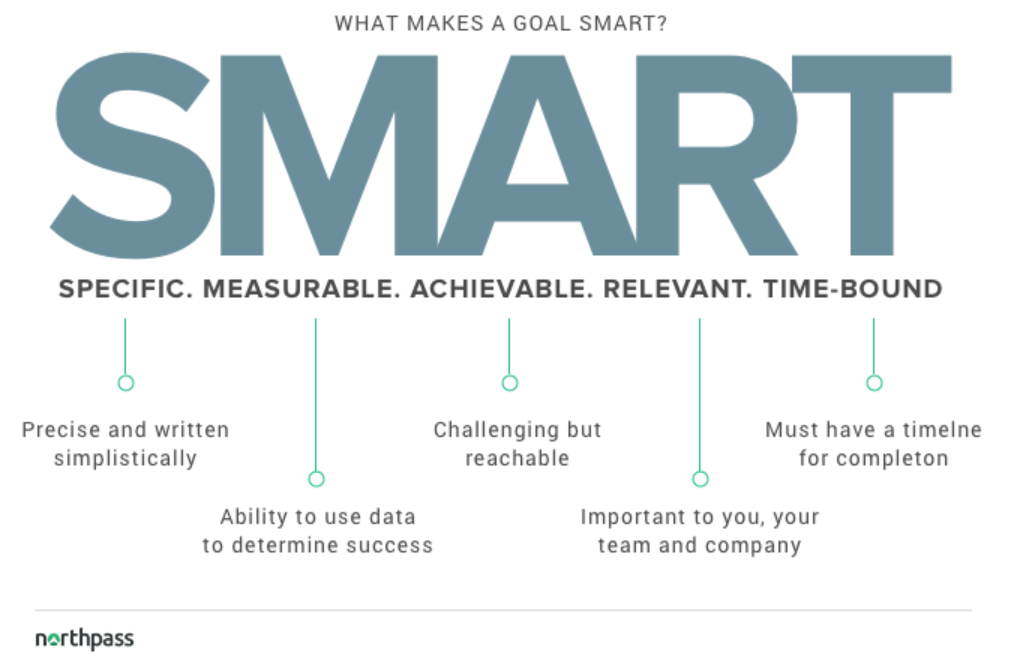
When you list out your goals, don’t merely include ‘increase brand awareness’ in your plan – define what ‘brand awareness’ means for your blog post. Is it a specific number of website visitors? A targeted increase in social media mentions? Spice up these goals with a touch of gamification for your blog post checklist.
Assign point values to different KPIs and create a progress bar or badge system to track your blog post’s performance and boost motivation. For instance, if you want to level up your content marketing game, your goals can look like this:
- Increase website traffic by 20% in 1 month (20 points)
- Achieve a 5% conversion rate on lead magnet downloads (20 points)
- Gain 20 backlinks to the blog post (20 points)
To achieve these goals, create a visual progress bar that fills up as you reach your goals. Award badges like Content Climber for reaching 20 points, Content Champion for 50 points, and Content King/Queen for achieving all goals. It will spice up your writing journey.
3. Keyword Research

Writing top-notch content isn’t enough, you must make sure that people get to read it too. This is where keyword research bridges the gap. It doesn’t mean you have to stuff every keyword in the list and magically expect your blog posts to rank. Instead, be strategic and focus on naturally integrating the keywords. Use it as a framework to stay on track and indicate to search engines what your piece is about.
If you’re new to keyword research, the first step is to educate yourself on how to do keyword research. Next, explore tools like Google Keyword Planner or Ahrefs and select keywords representing your blog post’s core topic. For instance, if you have a skincare blog, search general topics like;
- Facewash for oily skin
- Moisturizers for winter
- Skincare routines
Later, move deeper and focus on long-tail keywords. Statistics suggest that long-tail keywords make up 70% of all search traffic. It shows that users are getting specific, so shorter keywords might be difficult and not worth the extra effort.
They may have a lower search volume but they boast a higher conversion intent – meaning users searching for them are further along the buyer’s journey and more likely to take action, like downloading your freebies and resources.
If you want to get even more strategic, use tools like SEMrush to analyze your competitor’s content and identify their ranking keywords. Another aspect to focus on while performing keyword research is search intent. Are users looking for information, a specific product recommendation, or how-to instructions? When you craft blog posts around a strong keyword and match your content accordingly, you can easily rank high on SERP.
4. Create an in-depth outline
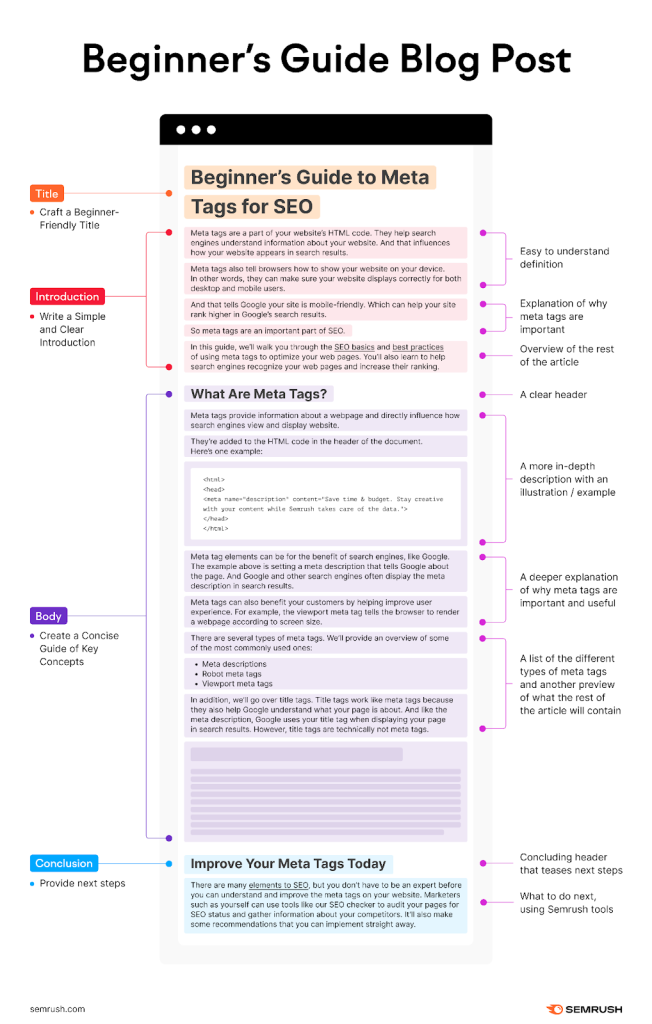
I write between 15,000 to 20,000 words every month for my clients while managing my studies at University. Despite the tight schedule, I managed to rank 85% of articles below 5 on SERP and earn a significant amount of conversion rates for my clients (mainly through BOFU content).
How do I manage it?
Two words. In-depth Outline.
Creating an outline and getting it approved beforehand can save you from tons of edits. It keeps you and your editor on the same page and gives an idea of the sections to include and omit. Moreover, it enables new writers to meet specific content goals, match the brand voice, and fulfill the search intent.
Here’s how this strategy fits into your blog post checklist.
If you don’t have a content brief, start by exploring the ranking articles and building out sections that must be included. You can use mind-mapping tools to brainstorm ideas freely and visually connect related concepts. It will help you identify potential subheadings and the overall flow of your content.
Next, organize the topics into H1, H2, and H3 headings. It makes your article appear visually pleasing which in turn improves the user experience. Once you lay out the basic elements, start adding subheadings, supporting arguments, and potential data sources in each section. This way, you can add unique angles to each section and add depth to the blog post.
During Writing Blog Post Checklist
The killer blog posts you read online don’t just happen. From interviewing SMEs to ensuring a smooth transition between each paragraph, there’s a lot that goes into writing blog posts. Here’s a list that you can use while you sit down to write your next masterpiece.
1. Write headlines that turn heads
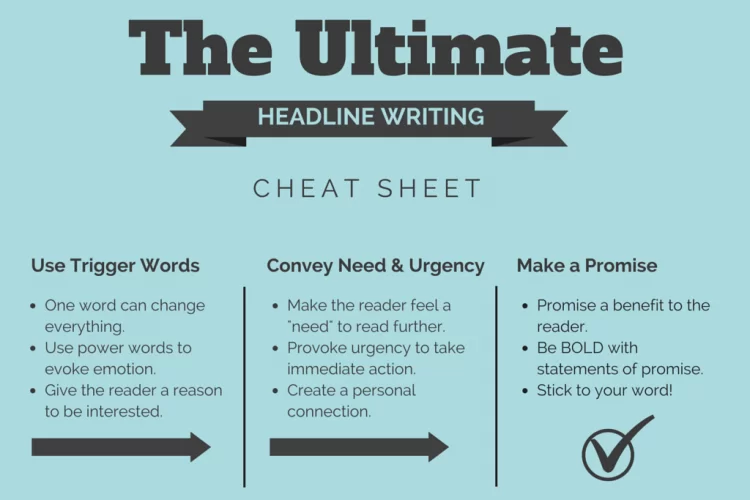
In the B2B marketing world, first impressions are everything. After all, if headlines didn’t hold immense power, copywriters would be out of a job! But crafting a great headline can be tricky. You need to grab attention and spark an emotional connection to get those clicks.
But how can I ensure that my headlines stand out?
Firstly, your word choice must be apt for your ideal audience. If your headline contains advanced lingos while you target people with basic knowledge of the subject, you won’t get more clicks. Here are examples to follow.
Secondly, ensure that your headlines stay under 60 characters. Because if it gets cut off on the SERP, all your efforts would be down the drain. To avoid this, you can run your title through the title preview tool by MozBar.
Thirdly, generate as many variations as you can. As a golden rule, generate at least 7 different variations of headlines. This way, you get multiple options to choose from.
2. Create an introduction that hooks people
Once readers open your blog post, give them a reason to stay. Here’s a tip for your blog post checklist: Instead of reiterating the main title, include something fresh that engages curiosity or an emotional response from the reader.
Once readers open your blog post, give them a reason to stay. Instead of reiterating the main title, include something fresh that engages curiosity or an emotional response from the reader. Make your content sound relatable by weaving in common pain points. Take a look at this intro written by Bani Kaur. She perfectly uses the storytelling element to connect with the readers.
(Source: Wordtune)
While we’re at it, writers also choose to add surprise factors or bold claims (obviously realistic) to invoke emotions in the readers. But here’s the twist, you don’t have to write positive sentences every time. You can use controversial statements to fuel reader’s curiosity and drives them to want to read more. Take a look at this piece, for instance
“Can video games actually make you SMARTER? We’ve all heard the complaints: rotting brains, wasted time. However recent studies suggest video games can enhance cognitive skills like problem-solving and memory. Is it time to rewrite the narrative on gaming, or is this just another industry ploy?”
It doesn’t matter what element you use in the introduction (rhetorical questions, quotes, anecdotes, or description), the end goal is to intrigue your target audience and keep them hooked till the end.
3. Structure for Scannability

People don’t read blog posts the way they read novels. They want clear and concise information, as fast as possible. It means organizing each section, sub-section, and content with clear intention and maintaining a steady flow between paragraphs. The goal is to convey the message in the least amount of words as quickly as possible. Making your content visually appealing will naturally compel your readers to skim the content till the end.
The best part?
Making your blog posts skimmable is super easy.
Start by breaking your content into different sections using proper heading tags (H1, H2, H3….) and let them scan content easily. This way, they can easily head towards a section that interests them. If you want to make a sentence or a word stand out in a particular paragraph, use bold, italics, highlight, and underline options.
To save your readers even more time (which is a good thing!), you can further add bullet points, block quotes, and short & simple sentences. Another element to make your paragraph stand out is using sentences that vary in length. A combination of short and long sentences will keep the readers engaged.
4. Add depth, not fluff
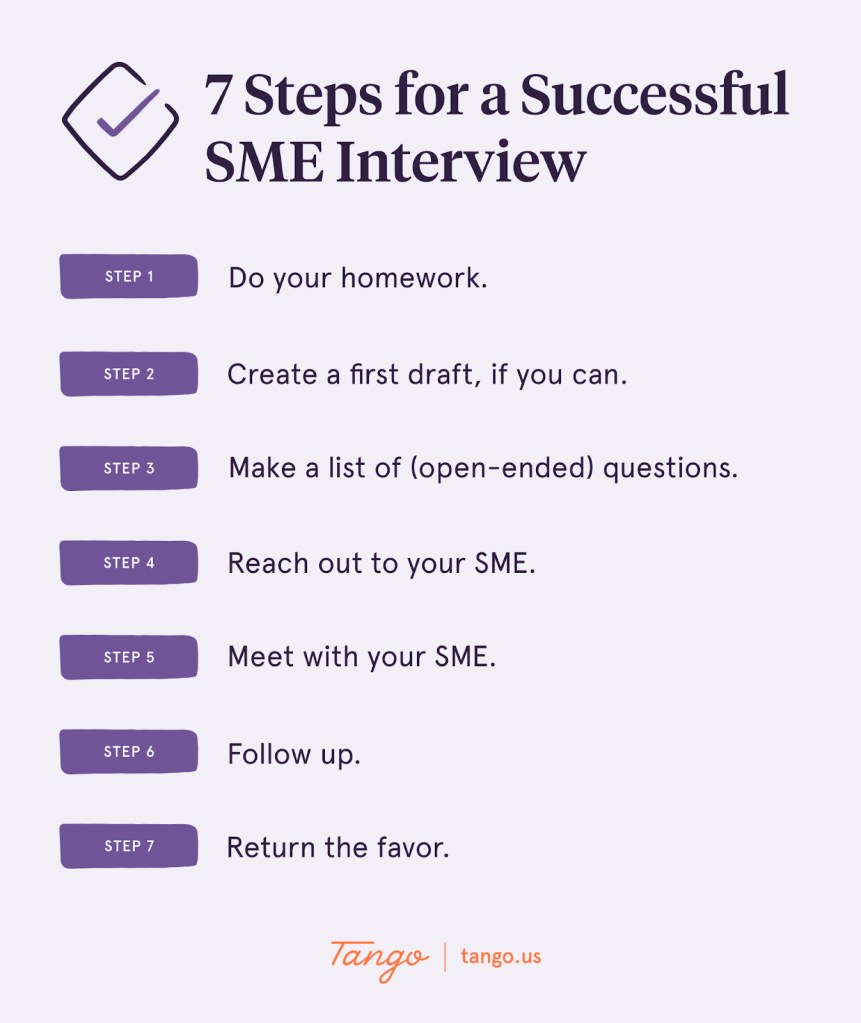
Every online writer dreams of earning a high SERP rank for their articles. However, only the ones who focus on writing in-depth content achieve it. Here’s a tip for your blog post checklist: Stop regurgitating the generic information that saturates Google’s first page. Instead, focus on writing unique and specific blog posts that perfectly align with search intent.
Backlinko claims that the average Google first page result contains around 1,890 words. It shows that long-form content is not going away anytime soon. However, while you try to fit in more words in your article, it’s necessary to ensure that you don’t add for the sake of adding.
An effective way to add depth and credibility (without bringing in fluff) to your content is by talking to industry leaders. Seek out interviews with Subject Matter Experts (SMEs) in your field. Their fresh insights can not only validate your information but also potentially attract their audience to your blog, expanding your reach.
No doubt, facts & figures are powerful tools, but raw data can leave readers feeling less convinced. If you truly want to capture the attention of your audience, weave your data into a captivating narrative. Tell the story behind the numbers – how were they obtained? What do they reveal about the real world? It will make the information more relatable and memorable for your readers.
Apart from presenting your perspective on a matter, consider including alternative viewpoints and even counter-arguments. Don’t shy away from questioning commonly held beliefs within your field. Are there industry “secrets” you can debunk or reframe in a new light? When you explore these different perspectives, you establish yourself as a thought leader with a well-rounded understanding of your topic. Moreover, it adds intellectual depth and offers a better reading experience for your audience.
Post-Writing Blog Post Checklist
Creating a blog post doesn’t stop after you finish writing the conclusion. You must ensure smooth transitions between sentences, add appropriate visuals, avoid erroneous links, etc. Here’s a quick checklist to keep in mind.
1. Edit, Edit, and Edit
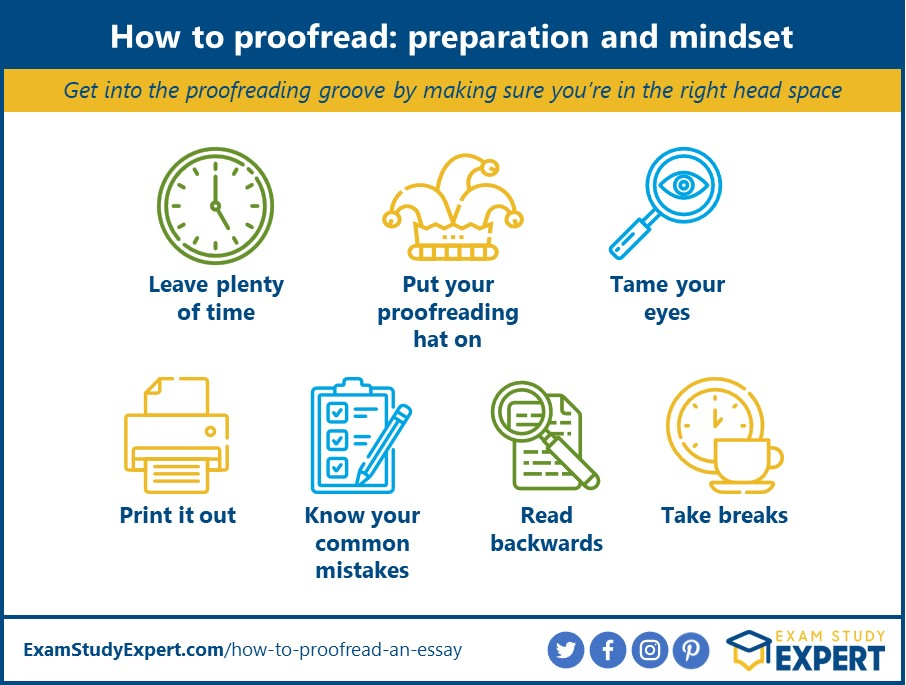
Imagine a landing page riddled with spelling errors – it sends a subconscious signal that the product or service itself might be similarly flawed. Most readers don’t want you to write perfect English on your blog post checklist, but they do expect you to strive for clarity and professionalism.
Error-free content isn’t about achieving some unrealistic standard of perfection, it’s about respecting your audience’s time and attention. Typos, grammatical stumbles, and factual inconsistencies can all create a perception of carelessness. No doubt, it can dilute the impact of your message.
When it comes to editing a blog post, the worst thing you can do is to limit yourself and only look for typos and spelling errors. Move part Grammarly and pay close attention to sentence formation, content flow, and smooth transition between different ideas.
One way to do this is to read your content aloud. This simple trick can easily expose awkward phrasing and inconsistencies. Another trick is to use the ‘parallel construction’ where you similarly structure your sentences to provide better clarity and easy comparison between ideas. An example is “Strong coffee fuels my mornings, creative writing ignites my afternoons, and a good book lulls me to sleep at night.”
Most importantly, don’t underestimate the power of stepping away. Let your content sit for a while, then return to it with fresh eyes. This allows you to catch errors you might have missed during the initial writing process.
2. Link more internally and externally

If you want to make your content juicy, you have to squeeze in valuable information, solutions, and offers. It includes directing your audience to specific pages of your website or that of others. 92% of marketers believe that links will still be a key ranking factor in Google’s algorithm in the next 5 years.
Links connect your blog posts to other relevant content on either your site (internal linking) or an external site (external linking). Let’s say you’re writing about hiking essentials. You can link to a post on “choosing the right backpack” or “essential first-aid kits for hiking.” This helps your readers discover more of your valuable content and increases the time they spend on your site.
No matter how many links you add to your blog post, ensure that you don’t force links. Weave them in naturally when the topic aligns with another post on your site. Also, use a mix of anchor text (the clickable text). Instead of just using “click here,” use descriptive phrases like “discover more about…” or “learn how to…”. This entices readers and gives them a clearer idea of what to expect when they click.
Pro Tip: Link to both older and newer content. Linking to older, evergreen content keeps it relevant and helps distribute traffic across your site. Linking to newer content encourages readers to explore your latest offerings.
Read more: Best practices to add internal and external links to your website
3. Add a Call to Action (CTA)

Your blog can be as captivating as Biryani, but without the audience asking questions at the end – it’s pointless. Adding CTAs to your blog posts is your chance to tell them exactly what you want them to do next. Do you want them to subscribe to your email list? Download an ebook? Sign up for a free consultation. A clear CTA removes any confusion and increases the chances of getting the engagement you desire.
Additionally, CTAs are a fantastic way to grow your email list, social media following, or client base. When you offer incentives like a free guide or exclusive discount, you entice readers to provide their contact information or connect with you further. It helps you to nurture leads and build long-term relationships.
When you choose a CTA, keep it clear and concise. Use strong verbs that leave no doubt about the desired action. Instead of a generic “click here,” opt for something like “Download your free SEO checklist now!” or “Subscribe for more marketing tips!”.
Another trick is to highlight the benefits. People are action-oriented when they see a clear benefit. Briefly showcase what they’ll gain by taking the next step. “Get 10% off your first purchase” or “Unlock exclusive content” are strong examples that entice clicks.
Most importantly, ensure that the CTA is specific to the blog post and meets goals. If you’re offering a free consultation, promote it at the end of a post about your consulting services. If you want email signups, offer a relevant lead magnet like an ebook or cheat sheet.
4. Optimize for sharing

You can create a masterpiece and still be miles away from YOUR audience. When you optimize your content for sharing, it’s like giving your post wings and allowing it to reach a wider audience.
When people share your blog post on social media or other platforms, it creates backlinks to your site. Search engines love backlinks, as they signal that your content is valuable and trustworthy. This can significantly improve your search engine ranking and drive more organic traffic to your website.
Compared to paid advertising, optimizing for sharing is a cost-effective way to get your content seen. By making it easy and enticing for people to share, you leverage their networks to spread your message organically.
Not to mention, shares act as social proof – a built-in endorsement system. Seeing others share your content tells potential readers that it’s worth their time. This increases the credibility of your blog and makes people more likely to trust your expertise.
Blogging doesn’t have to be this tough if you outsource it to the right person.
Outsourcing your blog writing to a skilled freelancer can be a game-changer. Here’s why:
- Fresh Perspectives: An experienced writer can breathe new life into your content strategy while offering unique angles and insights that resonate with your target audience.
- SEO Expertise: They’ll ensure your blog posts are optimized for search engines, increasing organic traffic and lead generation.
- Time-Saving Solution: Focus on running your business while a professional writer takes care of content creation.
In addition to outsourcing, do you want to consider creating a comprehensive blog post checklist to streamline your internal content creation process at a super affordable price?
